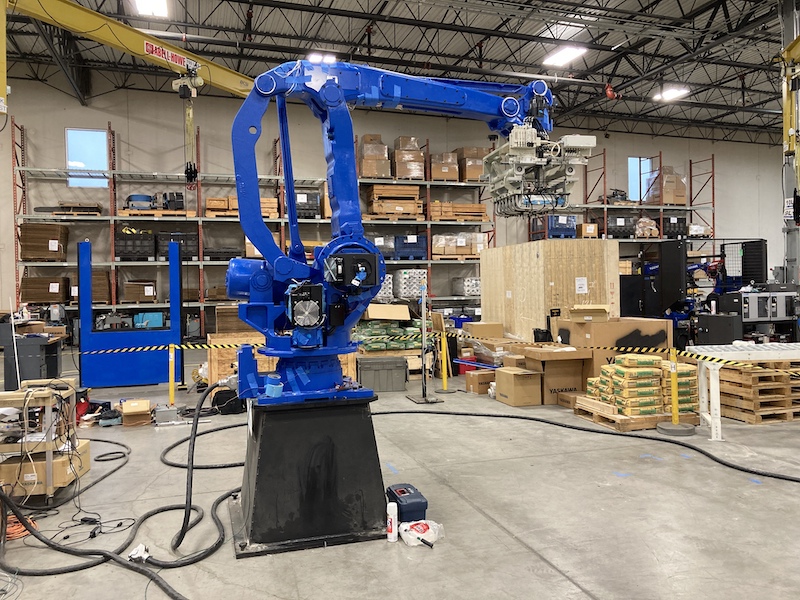When Yaskawa Southern Africa was contacted about Danone’s new automation project in Boksburg, the industrial robotics manufacturer teamed up with one of their preferred suppliers, Tectra Automation, a division of Bosch Rexroth, to offer a turnkey solution.
Yaskawa brought forward its automation expertise to Danone, answering the multinational’s challenge with additional lifting capacity and speed, thanks in no small part to its PL 190 palletising robots.
The request
“Danone needed a fully-automated palletising system. Until that point, all of the palletising was done by hand, which is labour-intensive and has an increased risk,” explains Hannes Crouse, sales manager at Yaskawa Southern Africa.
Manually loading pallets has a history of injury risks. This is because workers sometimes have to manoeuvre into awkward postures to move objects around.

The installation of an automated palletising system allows manufacturers to simplify the palletising process while also increasing reliability, accuracy, and repeatability. Due to how automated palletizing systems operate, relying on the robot’s accuracy and flexibility decreases injury risk and downtime while also solving ergonomic problems.
The challenge
Due to the size and complexity of the palletizing system, the system had to be installed and commissioned in phases.
“Large, complicated projects will always have challenges,” says Jaco de Beer, System Engineering Manager at Tectra Automation. “We worked through various technical challenges from cycle time issues to finding solutions for very limited space constraints in both width and height.
“Working closely with Yaskawa, we were able to solve those problems. Additionally, having various SKUs makes the automation process more complex. For example, some products may need to be rotated on the infeed side before they reach the robot. Lastly, we needed to make sure that the entire system meets stringent European safety standards.”
At the start, Yaskawa and Tectra Automation had to plan around multiple pallet patterns, a challenging endeavour for any large-scale automation project.
The way that goods are packed is not always “robot-friendly”, as robots want to pick up as much as possible in one cycle to make it cost-effective. The team needed consistent close cooperation with Danone if they wanted to get the cycles just right.
The initial request was for Yaskawa to supply nine robots, but by refining the cycle plans, they managed to bring that number down to seven.
The solution
To tackle the project in the most pragmatic way, the teams at Yaskawa and Tectra opted for a three-phase approach. There would also be three different cells that made up the system: a palletising cell with a Yaskawa PL 190 robot, on the inside, a destacker, and a stretch wrapper.
The PL 190 is the successor to the popular NPL 160, with improvements in faster motion, the ability to handle bigger payloads, and an overall sleeker design; a necessity for Danone’s limited space.
As more space became available on the floor, the team would install a new cell in the area and conduct commissioning before running the product through it and beginning the testing phases.
Yaskawa’s deliverables included a robot base and a robot with a gripper attached. As well as two robotic technicians that specialised in programming applications working closely with Tectra Automation and multiple others that helped with the mechanical installation.
Setting parameters and programming precise movements are the metaphorical moulding putty that works to form the individual automation tools at your disposal into a custom turnkey solution.
“Another key element of the system comes in the form of the two de-stackers. A destacker holds a stack of empty pallets and feeds the system one pallet at a time to a ready location for the robot that requests it via a signal,” explains Crouse. “And for that, we also used automatic carts, which are controlled, along with the entire system, with industrial Wi-Fi communication.”
De Beer elaborates on this concept further: “When the system pulls a pallet, you will have one empty pallet on standby at the robot station and another that it’s busy palletising on.
“When the current pallet that is being palletized is full, it will automatically eject onto another cart system that takes it to a wrapper. It’s then automatically wrapped and ejected once more where it is loaded onto the cart again and moved through to logistics.”
The result
Today, Danone’s palletising system consists of seven robots with two destackers in the middle. There are also special slip sheets between a set number of boxes to give stability to the pallets, which automatic carts collect and move from one stage to another via a rail system.
The system was designed to handle a max throughput while the robotic palletising cells achieve an efficiency of 98 percent. “It’s now fully automated,” says Crouse. “From where we start, it gets palletised, stacked, wrapped, and sent to logistics for transport. It’s a stable production.”
Operators can now be trained at a higher level to manage parameters and keep an overview of the system while the heavy lifting moves off to the robots. Manufacturers that adopt automation understand that the future is about maintaining efficiency, quality, and reliability. This, in turn, leads to higher profit margins.
It should also be noted that automation solutions of this scale are not a one-time deal, but rather a continued partnership. Specialists from contractors like Yaskawa and Tectra Automation provide training for all operators and technicians prior to the handover process and continue to support the system well after project completion.
